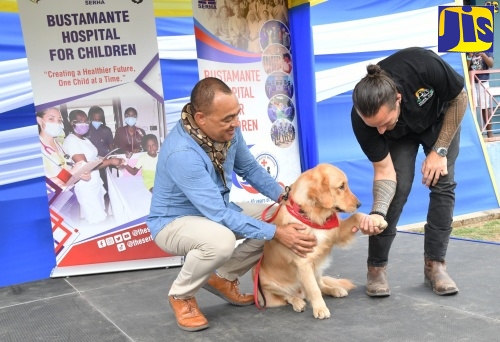Animal Assisted Recovery Care Project Brings Cheer to Ailing Children
By: , January 3, 2024The Full Story
When Dr. Teddy Barks is on duty at the Bustamante Hospital for Children (BHC) you can feel the excitement of the children, see their wide smiles and for a moment many temporarily forget their surroundings as they embrace him.
Dr. Teddy Barks is a golden retriever that is part of the Animal Assisted Recovery Care (AARC) Pilot Project, which was launched at the Hospital in March 2023.
The animal is owned by the BHC and cared for and maintained by the Hope Zoo.
All other animals, including a snake, birds, rabbits and kittens are from the Jamaica Society for the Prevention of Cruelty to Animals (JSPCA), the Hope Zoo, and Montego Bay Animal Haven.
The multidisciplinary collaborative effort was launched in March as part of the hospital’s 60th anniversary celebrations.
The AARC pilot is proving to be beneficial to the participants and receiving positive feedback from all stakeholders.
Under the project, there are monthly interactions and educational sessions with pre-selected patients and the animals.
Each session is held with an average of eight patients.
Parents and staff also benefit from additional visits and interactions with the animals.
Programme Coordinator, Ear, Nose and Throat (ENT) Consultant, Dr. Marsha James, is happy with the project, so far, and tells JIS NEWS that she hopes that it will continue.
The 18-month pilot is now at the six-month mark and is due for evaluation.
She notes that the children were initially cautious, “but with the help of our stakeholders, they are educated about the animals, and with time, they have become much more interactive”.
She says the parents have been very supportive, as they also interact with the animals.

A survey revealed that the therapy dog, Dr. Teddy Barks, is the overwhelming favourite, followed by the snake.
Dr. James explains that based on the studies, the target group is children who can follow instructions.
“We start at about age four and we go to 12. We do have some younger children who participate along with their parents and we’ll support the patients for that interaction. They do more touch and less interaction than the older patients,” she explains.
The older patients can hold the animals and give them treats.
“They are allowed to take the dog for walks and to stroke and feed the kittens. They also like to interact with the snake, which they sometimes put around their necks to take pictures,” Dr. James informs.
She explains that the objective of animal therapy is to foster a human-animal bond, to help to relieve anxiety, to improve cardiovascular outcomes and to improve mental health.
She also points out that when children are admitted, especially for extended periods, some of them are traumatised from the hospitalisation.
“They are sometimes isolated from their families and friends and even their own pets at home, so this session allows them to interact, to socialise, to create that bond and to get that feel-good experience from interacting with the animals,” the programme coordinator contends.
She highlights two patients, one from the ENT ward and another from the Intensive Care Unit (ICU), who have thrived under the programme.
“The ICU patient has interacted with Dr. Teddy Barks at each session, and we have seen that bond developing,” she tells JIS News.
The programme coordinator explains that animal-assisted recovery is therapy that is recommended for adults and children.
However, most programmes target children, who are generally more receptive.
Studies have also shown that animal therapy is very helpful to patients with mental health disorders.
The Bustamante Hospital was chosen for the pilot for several reasons, including the fact that the facility had the space to accommodate the project, and the opportunity provided to determine the receptiveness of the children to the undertaking.
The long-term goal is to launch the project in other health care facilities to benefit both paediatric and adult patients.
There are strict inclusion criteria that must be met for patient participation.
There must be consent from parents as well as assent from patients.
The patient must be willing to interact with the animals because reluctance from the children can cause anxiety to the animals.
“You have to protect the animals as well as the patients,” Dr. James points out.
“We still have to maintain COVID-19 protocols, and of course, these are hospitalised patients, so we don’t want cross-infections. “We divide them into groups of two and we transition them from one station to the other. We usually have about three or four stations and we’ll have no more than two children at a station at a time, and there is sanitisation between stations,” Dr. James tells JIS News.
The entire session lasts about an hour and an additional half hour is given to accommodate staff members.
Extra care is taken, however, not to exhaust the animals, as their health is also important.
The AARC Pilot Project is a collaborative effort conceptualised by Minister of Health and Wellness, Dr. the Hon. Christopher Tufton, in collaboration with the Veterinary Services Division of the Ministry of Agriculture, Fisheries and Mining, Hope Zoo, the JSPCA and Montego Bay Animal Haven.

Speaking at the launch in March, Minister Tufton said that animal-assisted interventions are globally recognised as having varied benefits for both patients and providers while adopting a One Health Approach to healthcare delivery.
It is funded by the National Health Fund (NHF) and is being handled under the South East Regional Health Authority’s Projects Portfolio.
The project is the first of its kind in Jamaica and has a research component, which will allow the facility to gather data on the impact of the intervention on the healthcare system.
Based on the findings, the project will either be expanded into other health facilities or adjustments made accordingly.


